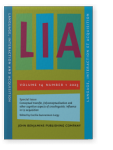Language-specific principles of discourse conceptualization in L2
English
In a previous series of crosslinguistic empirical studies in the
domain of narratives and picture descriptions, it has been shown that different
conceptual principles of discourse structure are built by L1 users based on
routine cognitive processes. These in turn seem to be induced by the underlying
language-specific properties of the L1s. Native speakers of Dutch and German,
for example, tend to conceptualize and structure the progression of the
narrative or description through linking devices in utterance-initial position,
primarily through the use of the protagonist or temporal/locative adverbials. In
contrast, native English speakers tend to prefer linking with the (syntactic)
subject in initial position. The present study shows how complex it is for very
advanced Dutch learners of L2 English to unravel these non-superficial
underlying conceptual discourse structures in their L2. The question is whether
they can overcome the routinized cognitive schemata of language processing that
go with their habitual L1 strategies of telling a story or describing a picture.
This paper shows how even very advanced Dutch learners can only partially learn
the narrative or descriptive strategies of native English speakers.
Article outline
- 1.Introduction
- 2.Theoretical framework
- 2.1Word order and information structure
- 2.2Information-structural transfer
- 2.3The present study
- 3.Methodology
- 3.1Design
- 3.2Participants
- 3.3Materials
- 3.4Procedure
- 3.5Analysis
- 4.Results
- 4.1Introductions in picture descriptions
- 4.2Linking in picture descriptions
- 5.Discussion and conclusions
- Acknowledgements
-
References
